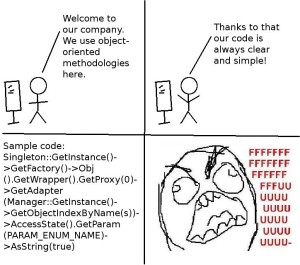Object oriented concepts in JAVA
- In a today’s competitive world, a need of an hour is to develop simple and speedy solutions that can be instantly applied to varied requirements, this is resulted in the creation of a different and sometimes, a complex software systems.
- However, complexity of a software is a reality, there are ways to ensure that this complexity does not become a stumbling block to the smooth functioning of the software.
- We can simplify complexity through the way, to split the software system into its component parts and arrange the parts in a hierarchy and this is very similar to the way in which the employee of an organization can be grouped according to the functions they perform and then arranged in a hierarchy.
- Before an Object Oriented Programming (OOP) came into an effect, a procedural programming language was in use. Programs are written by using a procedural programming approach consist of various functions. These functions can be executed anywhere within the program.
- A function in a program contains the instrumental steps that are performed to carry out an activities.
- The functions of a procedural programming are interdependent and therefore, those are difficult, to separate one from another.
- These interdependent functions cannot be reused in other programs. As a result, even for a similar task across programs, the entire functions have to be re-coded so, this task made programming complex.
- For example, you have a program, EmployeeDetails, coded in procedural programming language that keeps the details of employees of a bank. The program has a function, showDetails that print the details of each bank employee. This function may be called many times from different parts of a same program. If you want to show the details of employees of a different organization, such as an Airplane Reservation by using the same function, showDetails then you have to re-code it in another program.
- In addition, data in a procedural programming language is visible and accessible throughout the program, making it easy to manipulate the data from anywhere in the program.
- Procedural programming languages examples are COBOL (Common Business Oriented Language), Pascal and BASIC (Beginer’s All Purpose Symbolic Instruction Code).
- The limitations of the procedural programming led to the evolution of the object oriented approach. In an OOP the programs are broken into the independent chunks known as an objects, which can be integrated to create complete program.
- For example, in OOPS you can have Employee object that keeps the details of employees of any organization. The same Employee object can also has functions to show these employee details. Any program can reuse this Employee object.
- Thus, objects can be re-used across various programs, this enable a programmer to develop an application in a relatively shorter duration.
- OOP enables you to consider a real world entity as an object. OOP combines user defined data and instructions into a single entity called an object. In OOP, objects can be placed in libraries. An OOP also offers some built-in libraries and those libraries consents of a set of objects and pre-defined functions and can be used by all programs.
- Biggest advantage of OOP is the re-usability of the code because it saves the effort required to rewrite the same code for every program using the functions defined in libraries.
For more reading about technology news in singapore and seo to online marketing do view more about other pages.
